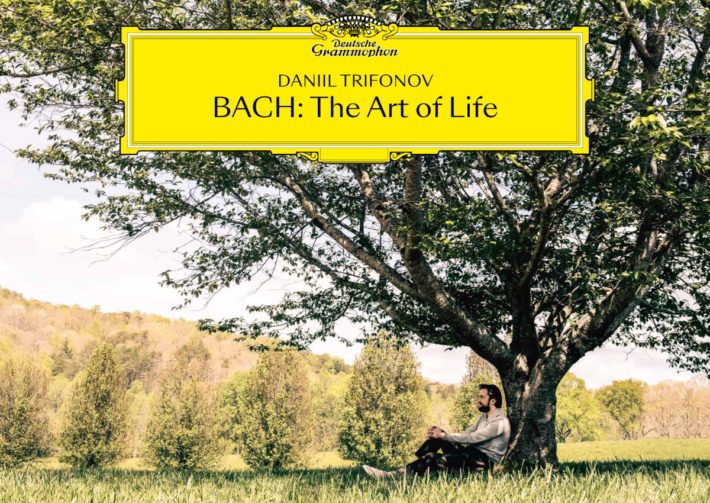Up until now, Daniil Trifonov’s output has largely embraced 19th and 20th century composers – Liszt, Chopin, Rachmaninoff, and Stravinsky to name a few. His newest release, the two-volume “Art of Life”, is an ambitious and large-scale venture into the Baroque era. Trifonov authors a musical narrative around J.S. Bach’s final work, The Art of Fugue, including works by several of his children and the Notebook for Anna Magdalena, among others.
The selections by Bach’s sons carry a levity that complements the gravitas of the works later on the album. J.C. Bach’s Sonata in A major (tracks 1-2) has both a sparkling clarity and an improvisatory feel in the Allegro, followed by a thrill in the racing triplets of the Presto. The variations on ‘Ah, vous dirai-je, maman’ (tracks 5-23), too, are delightful in their youthful charm. The graceful opening theme has its differences in articulation between phrases, with the first a question and the subsequent one its answer. Moments of exciting virtuosity await us as in Variation II as do lyricism in the Minore of Variation IV.
The Anna Magdalena series is not highly complex by any means, but it’s not to be passed up as simplistic fare, either. There’s much to be explored in the small details and that’s what Trifonov does. The jovial Musette in D (track 24) has added touches with its dynamic changes and chirping ornamentation in the repeats. Syncopations in the middle sections carry a nice oomph against the buoyant downbeats in the bass. The Aria that follows is not even a minute long, but the emergence of a middle voice amongst the accompanimental line creates a beautiful dialogue.
Brahms’ arrangement for the left hand alone of Bach’s “Chaconne” from the second Violin Partita is much closer to the original than the more famous arrangement by Busoni, Yet, it might leave listeners wishing for the latter’s grandiose writing, giving way to Trifonov’s pianistic capabilities.
Related Classical Music Reviews
- Review: “Silver Age” – Daniil Trifonov, Valery Gergiev
- Review: Bach – Well-Tempered Clavier, Book II – Piotr Anderszewski
- Review: Bach – Sonatas and Partitas for Solo Violin – Thomas Zehetmair
The album’s centerpiece, the Art of Fugue, does not disappoint, as we are introduced to a diverse array of personalities. Contrapunctus I (track 37), for instance, is marked by a solemnity that yet doesn’t dwell. Trifonov’s is a good 40 seconds faster than Angela Hewitt’s (2013 Hyperion), which has a much more deliberate but equally sensible approach – pacing aside, her phrases are marked by contours and at times an expressive vocal quality. While Trifonov brings out the themes clearly, there is more of a panoramic objectivity in his playing: the briskness, when combined with fluidity and a velvety tone, lets us hear how seamlessly all the voices work together.
For some, the opening may seem a bit reserved, but it shows how the performer has entertained a holistic view. Contrast and variety are essential in a work of such duration, and the pianist gives us just that in selections like Contrapunctus II (track 38). The dotted rhythms that run throughout are crisp and consistent rhythmically but reflect changes in color and character. The initial light ‘skip’ gains more substance as it helps build up to a robust conclusion. It’s an interesting take, given ones by Glenn Gould (from his CBC performances) or Pierre-Laurent Aimard (DG 2008), whose figurations are heavier and more insistent from the start.
What brings a certain poignancy to the Art of Fugue is of course its final Contrapunctus, left unfinished mid-phrase. Some pianists like Gould or Nikolayeva choose to leave it as is, creating a chilling effect in light of the moments of growth just moments prior. Trifonov opts for completion with his own ending, which seamlessly continues the motivic material. Stylistically, it’s a bit more modern, if you will, using the low bass registers and a hearty dose of pedaling to create a distant rumbling effect. However, it still preserves the intensity of Bach’s original writing, which we can appreciate particularly in the middle of the Contrapunctus.
The album was recorded in two locations: Mechanics Hall (tracks 1-35) and Siemens-Villa (36-57). One might perceive differences in the sound engineering, perhaps also attributable to the different instruments/venues themselves: the first set seems a bit brighter and up-close and the second mellower. This doesn’t necessarily detract from the listening experience. The liner notes by Oscar Alan are plentiful, weaving in descriptions of Bach, his family, and the works – all tied together with the performer’s ongoing commentary.

Bach: The Art of Life
Daniil Trifonov – Piano
Deutsche Grammophon, CD 4838530
Recommended Comparisons
Read more classical music reviews or visit The Classic Review Amazon store
Follow Us and Comment:
Get our periodic classical music newsletter with our recent reviews, news and beginners guides.
We respect your privacy.








